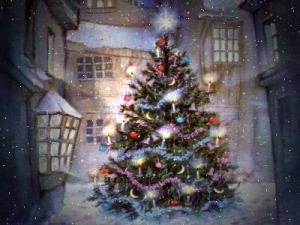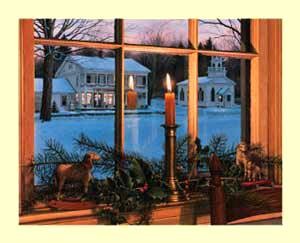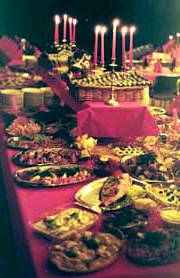There are reports of decorated fir trees before the Middle Ages. Some believe that the real beginning of the Christmas tree as we know it may be attributed to the 16th Century German theologian Martin Luther or another clergyman of his time.
The clergyman, according to legend, was walking through a forest at night and was overcome by the beauty of the green fir trees against the starlit sky above. When he arrived home, he wanted to recreate the beautiful scene for his children as he told them about his walk. So he brought a small fir tree into the house and decorated it with lighted candles.
 From this beginning, the custom of decorating a Christmas tree spread throughout Germany and into the rest of Europe.
From this beginning, the custom of decorating a Christmas tree spread throughout Germany and into the rest of Europe.
It was introduced into England by Prince Albert, Queen Victoria’s German husband, in 1841.
The German immigrants brought the treasured tradition with them to America, and Christmas trees have been a cherished part of our holiday season ever since.
The Christmas tree has gained in popularity in America since the middle of the 19th Century and is perhaps the foremost feature of Christmas celebrations.
Along with the bright lights, now much safer that the earlier candles, trees are decorated with colorful balls, religious symbols such as angels and crosses, glittering tinsel and chains of popcorn and cranberries.
Under the tree, in Christian homes, will frequently be found a creche of the nativity scene reminding us of the night Christ was born.
Anyone who has seen the beauty of a Christmas tree reflected in the wonder of a little child’s eyes knows it is among the most treasured of our traditions.
Month: December 2015
The Traditions of Christmas
The traditions of Christmas in America have their roots in many lands, a reflection perhaps of the many nationalities and cultures that make up our nation of immigrants. In this blog we will take a look at the traditions emanating from Rumania and Syria.
From dawn until after sunset on Christmas Eve, Rumanian boys visit neighboring homes to sing a Christmas greeting, Colinde, for which they receive apples, cakes and coins. On Christmas Day they parade through the streets carrying a great wooden cross which is hung with little tinkling bells. The star is illuminated from within by a candle, and is decorated with a transparency of the Baby Jesus and the Magi. Roast pig is the principal food of Christmas dinner.
An ancient Rumanian custom, still practiced today, is called “Blessing the Danube.” Clad in costumes depicting Pontius Pilate, Herod and other biblical characters, people gather at the river bank to sing carols. A young boy breaks the ice and a wooden cross is thrown into the water. All scramble after it for the rescuer will have extraordinary fortune in the coming year.
Christmas Eve in Syria is spent in worship and prayer. A bonfire of vine stems is made in the middle of each church in memory of the Magi who were cold from their journey.
 Many Syrians journey to Bethlehem to attend midnight services in the Holy Land. Christmas Day is observed chiefly in the home with prayers and quiet rejoicing.
Many Syrians journey to Bethlehem to attend midnight services in the Holy Land. Christmas Day is observed chiefly in the home with prayers and quiet rejoicing.
Young Syrian boys and girls, masked and dressed in gay costumes, go singing from door to door and receive coins, eggs and candies in return.
Legend tells that the youngest camel who carried the Wise Men to Bethlehem fell down, exhausted by the journey. The Christ Child blessed the camel and conferred immortality upon it. For this reason, a camel brings gifts to the children on New Year’s Day. Before going to bed that night, boys and girls set a bowl of water and wheat outside the house for the camel. In the morning, the good find gifts and the naughty find a black mark on their wrists.
The Traditions of Christmas
The traditions of Christmas in America have their roots in many lands, a reflection perhaps of the many nationalities and cultures that make up our nation of immigrants. In this blog we will take a look at the traditions emanating from Poland, England and Ireland.
In Poland families end a fast on Christmas Eve and gather for a dinner to honor the Holy Child. Before supper is served, the father of the house breaks the Christmas wafers, which are marked with Nativity scenes and have been blessed by the church. The father distributes the pieces to all who are present as tokens of peace and friendship. The meatless meal that follows has 12 courses, one for each Apostle.
In England, Christmas is a day of family gaiety and of feasting on turkey with roast potatoes, mince pies and plum puddings. Turkey also is the Christmas meal most chosen by Americans.
In Mexico, the flower of Holy Night, the poinsettia, is seen everywhere during the Christmas season and everywhere, in doorways and arches, there are pinatas. On Christmas Eve, children roam the streets breaking the pinatas with a long stick. When each is broken, a profusion of peanuts, fruits and candy showers down.
 On Christmas Eve in Ireland, candles are lighted and placed in every window of the house and doors are left ajar. The candlelight and open door are symbols of welcome, assuring the Irish people that no couple seeking shelter for a Baby who is the son of God will be homeless. The candlelight must shine forth all night long, and may be snuffed only by those having the name of Mary.
On Christmas Eve in Ireland, candles are lighted and placed in every window of the house and doors are left ajar. The candlelight and open door are symbols of welcome, assuring the Irish people that no couple seeking shelter for a Baby who is the son of God will be homeless. The candlelight must shine forth all night long, and may be snuffed only by those having the name of Mary.
A cup and saucer is placed on the table in each Irish home for the entertainment of wandering souls from purgatory, who are believed to come home for Christmas.
The Traditions of Christmas
The traditions of Christmas in America have their roots in many lands, a reflection perhaps of the many nationalities and cultures that make up our nation of immigrants. In this blog we will take a look at the traditions emanating from Scandinavia and Spain.
 In Sweden, pagan customs mingled with Christian ritual. In heathen times, it was believed that at Christmas the dead returned to earth, so food and drink were set out for them. Today, children set out food for Santa Claus.
In Sweden, pagan customs mingled with Christian ritual. In heathen times, it was believed that at Christmas the dead returned to earth, so food and drink were set out for them. Today, children set out food for Santa Claus.
In villages throughout Sweden young girls vie each year for the honor of portraying Saint Lucia on Dec. 13. On that day, a young girl clad in white with a crown of candles on her hair is followed by other young people carrying burning candles as sleeping families are awakened at dawn with an offering of wheat cakes and coffee.
Of course, the famous Scandinavian smorgasbord of cheeses, breads, salads and meats is replicated at holiday open houses and gatherings throughout America each Christmas season.
After weeks of Christmas preparations, homes in Finland are ready for holiday celebrations by noon on Christmas Day. A straw framework, decorated with paper stars suggestive of heaven, is suspended from the ceiling. Lighted from below by the glow of firelight and the Christmas tree, the framework produces a mysterious effect. Straw is heaped on the floor and, like the Christ Child, the children sleep on this manger-like bed.
In honor of Christmas Eve celebrations, each member of the Finnish family takes a traditional sauna or steam bath. After the sauna, all gather about the table while the head of the family solemnly reads the Christmas prayer and sermon. Little children visit other homes during the evening, but return early to see if the man dressed as a yule goat, Father Christmas, has left any presents for them.
Throughout Spain, Christmas is a time of devout religious ceremony that begins on the Feast of the Immaculate Conception on Dec. 8. Before midnight Mass on Christmas, little Spanish children dress in peasant costumes and enact an age-old Christmas Eve tradition of dancing around the Nativity scene to the musical accompaniment of tambourines.
The Christmas observance ends with the children receiving their gifts on Jan. 6. The gifts are said to be left by the Magi passing through on their way to Bethlehem. In the big cities, elaborate parades are held honoring the Three Kings.
Spanish children have no Christmas tree and do not hang up their stockings on Christmas Eve. Instead they hide slippers and shoes for Balthasar and the Wise Men to fill with goodies.
The Traditions of Christmas
The traditions of Christmas in America have their roots in many lands, a reflection perhaps of the many nationalities and cultures that make up our nation of immigrants. In this blog we will take a look at the traditions emanating from Germany, Italy and France.
 Many of the most cherished Christmas traditions have their roots in Germany. In Europe from time immemorial evergreen trees were brought into homes during the winter as symbols of unending life. It was in the Black Forest of Germany that the evergreens were first used as part of Christmas. And when Alsace was German, the tradition of adorning the fragrant firs and spruces with sparkling glass balls and garlands of tinsel began.
Many of the most cherished Christmas traditions have their roots in Germany. In Europe from time immemorial evergreen trees were brought into homes during the winter as symbols of unending life. It was in the Black Forest of Germany that the evergreens were first used as part of Christmas. And when Alsace was German, the tradition of adorning the fragrant firs and spruces with sparkling glass balls and garlands of tinsel began.
The colorful Advent calendars, with little windows to open for each day of the season, also originated in Germany as did the evergreen Advent wreath with four candles that is displayed in many homes with one candle lighted each Sunday until Christmas Eve.
Father Christmas, the kindly bearer of gifts, originated in the Teutonic lands and in Austria good Saint Nicholas parades through the streets in bishop’s regalia.
The Ceppo was the early Italian equivalent of the Christmas tree. Constructed of cardboard and three or four shelves, it was pyramidal in shape and stood about three feet tall. At the top, a pine cone or puppet was placed. Wax candles were lit along the sides and at the bottom, a Baby Jesus, made of wax or plaster, lay in a cradle amidst shepherds, saints and angels. The shelves held candy, fruit and small presents. Objects similar to the Ceppo often are displayed in American homes today, sometimes with the heat of candles placed on the lowest level providing heated air currents to turn an upper level causing chimes to strike.
In France, on Christmas Eve a glass of wine is poured over the Yule Log before it is ignited, and a late supper, to be eaten after midnight Mass, may be cooked over the blaze. In cities, where fireplaces are not common, the tradition is maintained by eating cakes shaped like logs and covered with chocolate icing to resemble tree bark. The luxurious meal eaten following midnight Mass consists of oysters and special wines and sausages. In some American homes, a light meal of oyster stew may be a holiday highlight following midnight Mass.
Many of the most cherished Christmas traditions have their roots in Germany. In Europe from time immemorial evergreen trees were brought into homes during the winter as symbols of unending life. It was in the Black Forest of Germany that the evergreens were first used as part of Christmas. And when Alsace was German, the tradition of adorning the fragrant firs and spruces with sparkling glass balls and garlands of tinsel began.
The colorful Advent calendars, with little windows to open for each day of the season, also originated in Germany as did the evergreen Advent wreath with four candles that is displayed in many homes with one candle lighted each Sunday until Christmas Eve.
Father Christmas, the kindly bearer of gifts, originated in the Teutonic lands and in Austria good Saint Nicholas parades through the streets in bishop’s regalia.
The Ceppo was the early Italian equivalent of the Christmas tree. Constructed of cardboard and three or four shelves, it was pyramidal in shape and stood about three feet tall. At the top, a pine cone or puppet was placed. Wax candles were lit along the sides and at the bottom, a Baby Jesus, made of wax or plaster, lay in a cradle amidst shepherds, saints and angels. The shelves held candy, fruit and small presents. Objects similar to the Ceppo often are displayed in American homes today, sometimes with the heat of candles placed on the lowest level providing heated air currents to turn an upper level causing chimes to strike.
In France, on Christmas Eve a glass of wine is poured over the Yule Log before it is ignited, and a late supper, to be eaten after midnight Mass, may be cooked over the blaze. In cities, where fireplaces are not common, the tradition is maintained by eating cakes shaped like logs and covered with chocolate icing to resemble tree bark. The luxurious meal eaten following midnight Mass consists of oysters and special wines and sausages. In some American homes, a light meal of oyster stew may be a holiday highlight following midnight Mass.